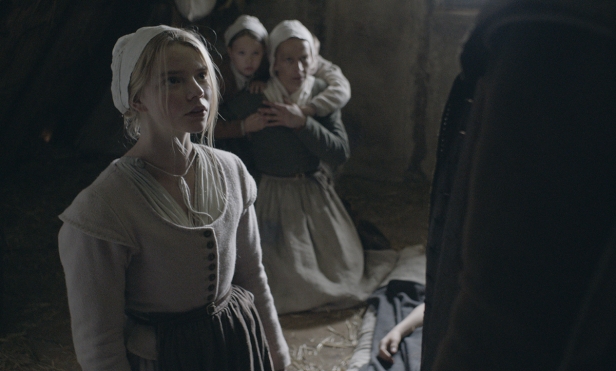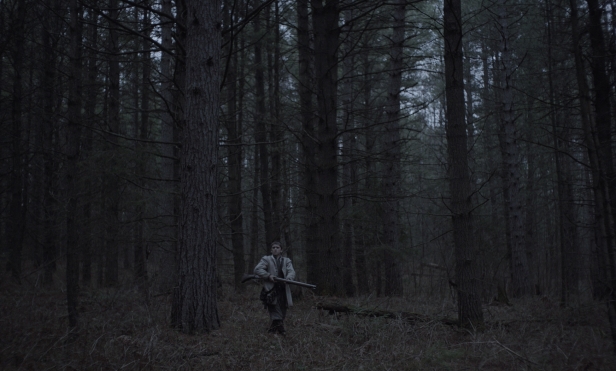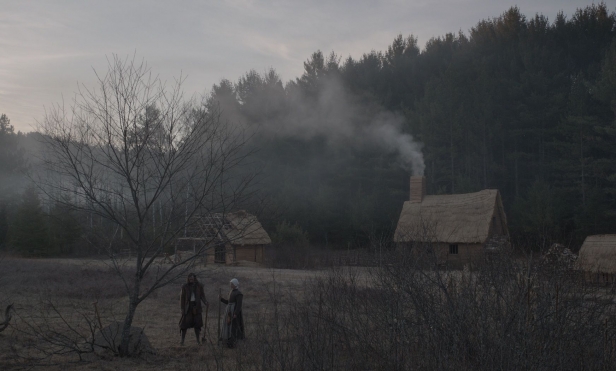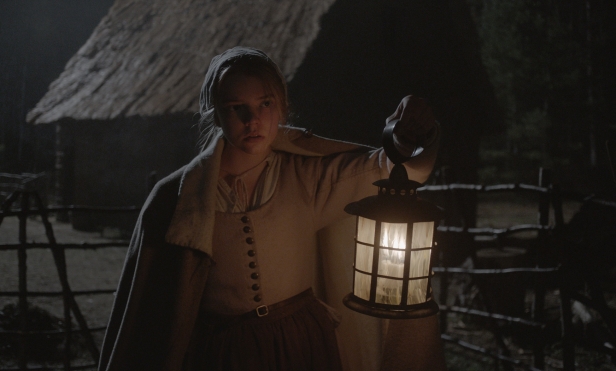Robert Eggers had every right to be cheerful when we sat down with him at the London Film Festival, as The Witch‘s wave of acclaim showed no signs of letting up. That was back in October, and the buzz around his 17th century New England horror has only grown.
“I’m a bit in disbelief!” he tells us. “I had to believe that there would be an audience for this movie, but right now the reaction’s been…I don’t know what’s going on in the zeitgeist but I’m happy and proud.”
The film is the story of a devout Puritan family who leave their plantation to be closer to God. They set up a house and a farm by the edge of the woods, but life is very hard, and when something terrible happens to one of their own, they begin to think that there might be something evil at work.
It’s such a specifically designed film, not just the sets but the look and the atmosphere. Had that been in your head from the start?
Yes, it was really essential that this 17th century world be depicted as authentically as we could possibly manage so that the witch could be real to audiences the way she would have been to people in the early modern period. It was a lot of work to create an atmosphere where it felt like that. Jarin Blaschke (the DP) and I were trying to make it as if we grew up in the 17th century, and we were sharing the memories of this time we had this talk with our dad in a cornfield and how he smelled, and that’s the goal. And the cinematic language of the film, I’ve been working with Jarin for seven years on my other shorts and on other people’s work, with me as a designer, and I feel like it’s a language we’ve been developing and honing.
The way the family behaves is obviously very close to the accounts of witch trials of the time, their fear is so real. Was that what drew you to the period and this kind of story?
I was basically just like “I want to make an archetypal New England horror story and therefore it’s going to be about witches and it’s going to be in the 17th century,” and then the research sort of dictated the direction that the story went. And the biggest epiphany, which seems intuitive but it was striking to me how true it was, was that aside from the extreme intelligentsia, in the early modern period the fairytale world and the real world were the same thing.
So in folktales and in historical accounts of witchcraft in these pamphlets and in court hearings, it’s the same material. So these tropes that existed through all these things, those need to be in the film. The ones that speak the most personally to me, those need to be in the film, these weird exotic half-forgotten bizarre things, those need to be in the film. That was sort of how I constructed the story.
Was that research something you enjoyed?
Yeah, very much, it was fascinating to really learn about the different aspects and offshoots of really extreme English Calvinism in the period and why and how people could find this the source of hope in their lives, because it does seem rather dismal looking back.

Did you have actors in mind for these parts? All of the performances are just fantastic.
Ralph Ineson’s someone I’ve been aware of for a while, and it was so great to work with him and he’s incredible, and awesome to see him in a lead role and just killing it. Kate Dickie is also incredible, I loved Red Road, you couldn’t dream of someone better because she’s always in the moment. But the kids were harder to find. It was hard to find kids whose parents would let them be in the film.
We had a really great UK casting director, Carmel Cochrane, and Anya Taylor-Joy was someone she was aware of and she was the first tape that I saw. I was kind of like “Well, that’s too good to be true.” But as soon as I worked with Anya in person, I was like, well, I guess it is too good to be true but thankfully it’s true, so…. The other kids took some more time and we ended up having to look in schools up North and doing a whole big to-do.
So it was very complicated but I was very pleased and I was extremely lucky to be able to cast who I wanted in this film. Casting people who were great actors but also really good people, so that we could work well together and have a loving family so that we could support each other when we were venturing into these dark, dark places. Of course, working with the kids, we weren’t terrorising them, it was kind of like Bressonian mannequin acting, like “Turn your head like this, breathe, hold your eyes,” and then you put music and the witch on the other side.
It’s a stunning location but was it hard to find somewhere that matched what you needed?
Yeah, it was very difficult. It just took months and months and months. We were shooting in Canada and there’s so much logging there that, in the region where we had the tax credit, there were all these tiny newly planted red pine forests, all these little trees in perfect rows, and I was like “This is horrible!” and we just kept searching and searching and searching for a place that had large secondary growth. It also had to be white pine and hemlock so it would look like New England, so it took a long time. But it was very exciting to find, and we pretty much shot the whole movie right around in those woods of that house, pretty much.
It was also difficult because we had to tie our schedule in knots to make sure that we were always shooting when it was gloomy. Any time the sun came out everyone was in utter despair and we had to move inside. It was really hard to maintain the look but I’m very proud of what we were able to achieve in our tiny shooting schedule with zero infrastructure because all the money was onscreen.

How important was it that the period detail be completely accurate?
Period accurate doesn’t mean good but in this film, it seemed like the right choice. It also rallies everybody creatively because you know how high the bar is. You know exactly where the bar is, and there was very little compromise. The biggest thing is that the farm, the clothing, you need the right materials, and the clothes need to be hand stitched, and there were just things that it needed to be to be acceptable and to be truthful. Forget about looking good, they need to be wearing wool and linen and hemp, that’s the only choice. That’s the end of the story.
Was it shot using natural light as well?
Yeah, pretty much. There are a few exceptions to this but pretty much everything was natural light and flame except for the night exteriors.
Was it difficult to find people to get on board with a film like this?
Yeah, it took four years and all three of my producers were really wonderful in understanding my vision and finding the investors who did too, that was very hard. I think off the page people thought this could actually be scary, a witch movie that’s scary, that’s cool, but the Jacobean English, among other things..
And the money that it was going to take, even as small a budget as it was, to make a convincing authentic world, a lot of people weren’t really interested, and it took a while to find people who were. The investors were incredible, collaborative and smart and gave excellent notes and really respected me and what I was trying to do and it was lovely.
 I wanted to ask about the music as well, because it adds so much…
I wanted to ask about the music as well, because it adds so much…
I was working with this fantastic Canadian composer Mark Korven, I wanted to use 17th century instruments and then twist it into dissonant chaos. Mark really was incredible because he knows how to play many of these ancient instruments and knows people in the music scene in Toronto, and also has an incredible knowledge and ear for dissonant 20th century classical music. I couldn’t have asked for anyone better.
He also knew about this choir, these women were incredible; the sound engineer was terrified when he heard them singing this stuff! It was very satisfying and very fun and there are certain times with the music, there’s no diagetic sound it’s just image and music, and there are certain things, emotions that I was trying to articulate that you need music to go there.
Were there any direct influences?
I always try to, respectfully, I try not to say “It’s a little of this, a little of that.” Obviously I have my influences, and it smells of Bergman and Kubrick and Dreyer and all that stuff, and also the DP and I are really into golden age fairytale illustration and I’m constantly into art books and museums and blogs looking at this canon of European classical painting up through the symbolists. There’s not any time where we’re trying to deliberately reference any thing. We weren’t trying to reference Goya but you just have to if you want to do it right. But your influences make themselves known. There’s nothing original about me but I just watch older movies and read older books! [laughs]
Finally, do you have a favourite cinematic witch?
My earliest childhood nightmares were all about witches and mostly Margaret Hamilton, the Wicked Witch Of The West. She packed a punch and when she shows up in the crystal ball, I was just like “Fuck that!” You can’t escape her. And that idea of the witch being something that was inescapable, that really stuck with me through this film.
The Witch is in UK cinemas now. Read our review here, our interview with Kate Dickie here and our interview with Ralph Ineson here, and keep up with the latest genre news with the new issue of SciFiNow.
